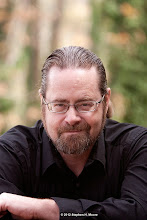I wasn't old enough to stay at home on the long weekends when the family all went deer hunting, so I got hauled along to leases out west of San Antonio, usually some rocky windswept ranch, usually to murder wildlife, which was very much not my thing.
On one such trip, I brought along one of those library-sale paper sacks full of treasures books.
One of those books was called The Amityville Horror.
The rest of the camp went out on a hunt right before twilight, because deer come out to forage at sundown, and that's apparently the best time to kill them. If someone "got" a deer--i.e., shot one-- they had to wait until the hunt was over to go out and find the unlucky creature and, if it wasn't dead yet, put it out of its misery. Sometimes the search-and-finish could last for hours, long after dark.
I almost always stayed behind in the camper. And read books. It was glorious.
Except that one time. With that one book.
I didn't know it then, but the evening hunt was pretty successful. Several deer were "got," and several searches ensued. I was alone in the camp with only the wind for company for miles and miles of dark Texas night. Just me and my delicious readable.
I considered myself fairly brave as far as books went. At least, I hadn't read one that stopped me from reading others. King and Koontz and Poe and Susan Cooper, not to mention all those collections of ghost ship stories and unsolved mysteries, had inured me to losing my shit over a book. I mean, they were just books. Just in my mind. All made up, fantasy stuff.
Right?
So I snuggled down in a sleeping bag, cracked open The Amityville Horror, and read blithely, bravely, decadently.
For those who haven't read the book or seen the movie (movies?) this starts off innocently enough. Normalish family moves into a house. It's a nice house, kind of fancy even, with a boat house. But (SPOILERS!) it's haunted as hell, and freaky stuff starts happening, and the dad goes a little crazy, and suddenly there's a demon pig in a rocking chair up in the attic.
Which was when something scratched on the side of the camper.
I kid you not. Something was out there. Scratching. Low, near the ground. Right below my camper window. A sound that was not the wind. It was close.
Scratch, scratch.
Scratch, scratch.
Remember, every human person was out in the night wilderness killing Bambi.
So what was scratching out there?
I sure as hell wasn't going to go outside and investigate. And I could not, could not just keep reading.
Demon. Pig.
That was totally a demon pig outside.
I closed that book, shoved it way, way down the sleeping bag, and huddled there in the camper, listening. Terrified. For hours.
Family got back eventually, skinned their kills, and iced down the meat, and then we all went to bed. Next morning, after I slept not at all, I woke up and checked out the side of the camper.
There were scratches on the side. True fact.
Never did finish that book.
(Happy Halloween, y'all.)
(Happy Halloween, y'all.)

















